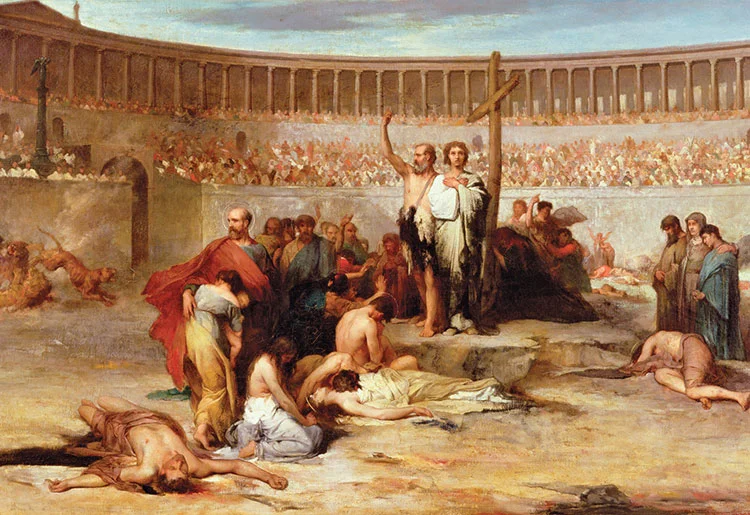
The Role of the Roman Empire in the Spread of Christianity
The rise of Christianity, a religion that would ultimately reshape the Western world, is inextricably linked to the Roman Empire. While its origins lie in the relatively obscure province of Judea, Christianity’s transformation from a small Jewish sect to a global faith owes a considerable debt to the political, social, and infrastructural framework provided by Rome. From the reign of Augustus to the conversion of Constantine, the Roman Empire acted as both a crucible of persecution and a catalyst for the unprecedented expansion of Christian thought and practice. This exploration delves into the multifaceted relationship between the Roman Empire and the burgeoning Christian faith, examining how Roman power, governance, and culture fostered – and at times hindered – the dissemination of Christian ideals throughout the Mediterranean and beyond. We will explore the influence of Roman roads, the impact of imperial administration, the pivotal role of cities, the legal framework of Roman law, and the lasting legacy of this complex interaction.
The Roman Road to Conversion: Infrastructure and the Spread of the Gospel:
The Roman Empire was a marvel of engineering and logistics. Its expansive network of roads, meticulously constructed and maintained, connected the vast empire with remarkable efficiency. These “viae,” extending thousands of miles, formed the arteries of communication and trade, facilitating the movement of goods, armies, and, crucially, ideas. The apostle Paul, a pivotal figure in the early expansion of Christianity, leveraged this infrastructure extensively. His missionary journeys, meticulously documented in the Acts of the Apostles, showcase the strategic use of Roman roads to reach diverse populations in major cities across the empire. He wasn’t merely traveling; he was utilizing a pre-existing system designed for rapid dissemination of information and influence.
The strategic placement of Roman cities also played a crucial role. These weren’t merely administrative centers; they were bustling hubs of commerce, culture, and social interaction. The diverse populations of these urban centers, drawing people from across the empire and beyond, created a fertile ground for the spread of new ideas. The concentration of people in cities offered Christian missionaries a readily accessible audience and a concentrated environment for establishing communities and churches. Antioch, Corinth, Ephesus, and Rome itself became crucial centers of early Christian activity, showcasing the symbiotic relationship between urban environments and religious growth within the Roman framework.
Imperial Administration and the Christian Community:
The highly structured Roman administrative system, while initially a source of persecution, ultimately contributed to the organization and spread of Christianity. The empire’s provincial organization, with its network of governors, officials, and tax collectors, provided a framework that – albeit unintentionally – facilitated the establishment of a parallel organizational structure for the Christian communities. The establishment of dioceses within the Christian church mirrors the Roman provincial system in its hierarchical structure and geographical division. The meticulous record-keeping of the Romans also unintentionally provided a framework for early Christian communities to document their own affairs, albeit with a distinctly different purpose.
While Roman officials initially viewed Christianity with suspicion and often instigated periods of intense persecution, this very persecution, paradoxically, strengthened the Christian community. The shared experience of suffering under Roman authority fostered a sense of unity and solidarity among Christians. The accounts of martyrs, individuals who suffered death rather than renounce their faith, became powerful symbols of unwavering devotion and inspired further conversion. These stories, spread through both oral tradition and emerging written texts, served to bolster the faith’s resilience and strengthen its appeal amidst adversity.
The Edict of Milan and the Constantinian Shift:
The year 313 CE marked a watershed moment in the relationship between the Roman Empire and Christianity. The Edict of Milan, issued by Emperor Constantine and his co-emperor Licinius, granted official toleration to Christianity throughout the empire. This decree, a radical departure from previous policies of persecution, ended centuries of intermittent but often brutal crackdowns on Christian communities. While the motivations behind Constantine’s conversion remain a subject of scholarly debate, the Edict’s impact was undeniable. It removed the legal impediment to the open practice of Christianity, allowing the religion to flourish openly without the constant fear of imperial retribution.
Constantine’s conversion, whether genuinely spiritual or a calculated political manoeuvre, had profound implications. His embrace of Christianity significantly altered the trajectory of the empire. The once-persecuted religion now enjoyed imperial patronage, leading to the construction of magnificent churches, the establishment of theological institutions, and the integration of Christian values into the imperial ideology. This shift dramatically altered the relationship between Church and State, laying the foundation for the eventual establishment of Christendom, a unique fusion of Roman governance and Christian faith. The conversion of Constantine didn’t simply grant tolerance; it established a powerful symbiosis between the imperial power and the burgeoning Christian church.
Roman Cities as Centers of Christian Life:
Roman cities continued to play a critical role in the growth of Christianity even after the Edict of Milan. The existing infrastructure and social networks within these urban centers provided a ready-made framework for the establishment of churches, cathedrals, and other Christian institutions. Public buildings, once dedicated to pagan deities, were repurposed for Christian worship, symbolically marking the shift in religious dominance. The transformation of Roman basilicas into churches exemplifies this physical manifestation of Christianity’s rise to prominence. These structures not only served as places of worship but also became centers for community life, education, and charitable works, solidifying Christianity’s presence within the heart of Roman urban life.
The cosmopolitan nature of Roman cities facilitated the spread of Christian teachings among diverse populations. The influx of people from across the empire, coupled with extensive trade networks, fostered a cultural exchange that helped disseminate Christian ideas to new audiences. The relative peace and stability provided by the Roman system, though punctuated by periods of instability, created an environment conducive to the establishment of strong and enduring Christian communities within urban areas. This urban concentration allowed for the development of theological schools, fostering intellectual engagement and shaping Christian doctrine.
The Influence of Roman Law on Christian Development:
The Roman legal system, renowned for its codified laws and established procedures, exerted a profound influence on the structure and development of the Christian church. The concept of canon law, the body of laws and regulations governing the internal affairs of the church, developed partially in response to, and in dialogue with, Roman legal traditions. The meticulous Roman approach to record-keeping and legal documentation provided a framework for the church to establish its own systems of governance and dispute resolution. The adoption of Roman legal concepts, particularly in areas like property ownership, inheritance, and organizational structure, enabled the church to manage its growing assets and maintain order within its own ranks.
Furthermore, the interaction between Roman law and the burgeoning Christian community shaped the way the faith dealt with issues of heresy, schism, and theological disputes. While Roman law initially persecuted Christians for their beliefs, the later adoption of Roman legal procedures provided a framework for the church to grapple with its own internal conflicts and define its own doctrines. The development of ecclesiastical courts and procedures reflects the enduring influence of Roman legal principles on the structure and function of the Christian church. This adaptation of Roman legal structures allowed the Church to establish its own internal authority, reflecting a subtle but significant transition of power from the Roman state to the burgeoning Christian institution.
Persecution, Martyrdom, and the Consolidation of Faith:
While the Edict of Milan marked a turning point, the early history of Christianity was punctuated by periods of intense persecution under Roman rule. These periods, far from extinguishing the faith, often served to strengthen it. The persecution of Christians, driven by accusations of atheism, subversive behavior, and a threat to traditional Roman values, forged a sense of shared identity and purpose among believers. The accounts of martyrs, individuals who bravely faced death rather than renounce their faith, became powerful symbols of resilience and unwavering belief. These narratives, passed down through oral tradition and later recorded in written accounts, served as potent inspirational forces, drawing in new converts and solidifying the faith’s commitment amidst adversity. The shared suffering became a potent force of communal bonding, fostering a deep sense of belonging and reinforcing the central tenets of the Christian faith.
The narrative of martyrdom, woven into the very fabric of Christian history, played a critical role in the propagation of the faith. The stories of individuals like Saint Stephen, Saint Perpetua, and countless others, who faced brutal deaths for their beliefs, became powerful testaments to the unwavering faith of the early Christian community. These tales served to inspire other believers, attracting new converts, and building a powerful mythology around the faith’s origins and endurance. The image of the persecuted Christian, defying imperial power, resonated profoundly, and in many ways, the stories of martyrdom inadvertently helped to promote the faith’s rapid spread.
The Enduring Legacy:
The relationship between the Roman Empire and Christianity was complex and deeply intertwined, characterized by both oppression and eventual cooperation. While Roman power initially sought to suppress the nascent faith, the very structures and systems of the empire unintentionally provided the means for its astonishing growth. The infrastructure, administrative system, and legal framework of Rome laid the foundation for the organization, spread, and ultimate dominance of Christianity. The conversion of Constantine and the subsequent acceptance of Christianity as the state religion marked a profound shift in the power dynamic, but the impact of Roman structures and culture on the Christian faith remained deeply imprinted.
The legacy of this interaction is evident in the structure of the church, its legal framework, its organizational hierarchy, and its adoption of Roman architectural and artistic styles. From the grand basilicas to the intricate canon law, the mark of Rome is indelible on the landscape of Christianity. The very language of Christianity, largely disseminated through the Latin language of the Roman Empire, serves as a lasting testament to the profound and enduring influence of Rome on the development and propagation of the Christian faith. The story of Christianity is not just a religious narrative; it is intricately interwoven with the political, social, and cultural fabric of the Roman Empire, a testament to the enduring impact of this remarkable historical partnership. The convergence of these two powerful forces indelibly shaped the trajectory of Western civilization, leaving a legacy that continues to resonate in our world today.


